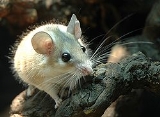
Myomorpha
Encyclopedia
Suborder Myomorpha contains 1,137 species of mouse-like rodent
s, nearly a quarter of all mammal
species. Included are mice
, rats
, gerbils, hamsters, lemming
s and voles. They are grouped according to the structure of the jaw and the structure of the molar teeth
. Both their medial and lateral masseter muscle
s are displaced forward, making them adept at gnawing. The medial masseter muscle goes through the eye socket, a feature unique among mammals. Myomorphs are found worldwide (apart from Antarctica) in almost all land habitats. They are usually nocturnal
seed-eaters.
Most myomorph species belong to superfamily Muroidea
:
Historically, the definition of the suborder Myomorpha has included one or both of the following.
Rodent
Rodentia is an order of mammals also known as rodents, characterised by two continuously growing incisors in the upper and lower jaws which must be kept short by gnawing....
s, nearly a quarter of all mammal
Mammal
Mammals are members of a class of air-breathing vertebrate animals characterised by the possession of endothermy, hair, three middle ear bones, and mammary glands functional in mothers with young...
species. Included are mice
Mouse
A mouse is a small mammal belonging to the order of rodents. The best known mouse species is the common house mouse . It is also a popular pet. In some places, certain kinds of field mice are also common. This rodent is eaten by large birds such as hawks and eagles...
, rats
RATS
RATS may refer to:* RATS , Regression Analysis of Time Series, a statistical package* Rough Auditing Tool for Security, a computer program...
, gerbils, hamsters, lemming
Lemming
Lemmings are small rodents, usually found in or near the Arctic, in tundra biomes. They are subniveal animals, and together with voles and muskrats, they make up the subfamily Arvicolinae , which forms part of the largest mammal radiation by far, the superfamily Muroidea, which also includes rats,...
s and voles. They are grouped according to the structure of the jaw and the structure of the molar teeth
Molar (tooth)
Molars are the rearmost and most complicated kind of tooth in most mammals. In many mammals they grind food; hence the Latin name mola, "millstone"....
. Both their medial and lateral masseter muscle
Masseter muscle
In human anatomy, the masseter is one of the muscles of mastication.In the animal kingdom, it is particularly powerful in herbivores to facilitate chewing of plant matter.-Origin and insertion of the two heads:...
s are displaced forward, making them adept at gnawing. The medial masseter muscle goes through the eye socket, a feature unique among mammals. Myomorphs are found worldwide (apart from Antarctica) in almost all land habitats. They are usually nocturnal
Nocturnal animal
Nocturnality is an animal behavior characterized by activity during the night and sleeping during the day. The common adjective is "nocturnal"....
seed-eaters.
Most myomorph species belong to superfamily Muroidea
Muroidea
Muroidea is a large superfamily of rodents. It includes hamsters, gerbils, true mice and rats, and many other relatives. They occupy a vast variety of habitats on every continent except Antarctica. Some authorities have placed all members of this group into a single family, Muridae, due to...
:
- Superfamily MuroideaMuroideaMuroidea is a large superfamily of rodents. It includes hamsters, gerbils, true mice and rats, and many other relatives. They occupy a vast variety of habitats on every continent except Antarctica. Some authorities have placed all members of this group into a single family, Muridae, due to...
- Family Platacanthomyidae
- Family SpalacidaeSpalacidaeThe Spalacidae, or spalacids are a family of rodents in the large and complex superfamily Muroidea. They are native to eastern Asia, the Horn of Africa, the Middle East, and south-eastern Europe. It includes the blind mole rats, bamboo rats, root rats, and zokors...
- Family Calomyscidae
- Family NesomyidaeNesomyidaeNesomyidae is a family of African rodents in the large and complex superfamily Muroidea. It includes several subfamilies, all of which are native to either continental Africa or to Madagascar...
- Family CricetidaeCricetidaeThe Cricetidae are a family of rodents in the large and complex superfamily Muroidea. It includes true hamsters, voles, lemmings, and New World rats and mice...
- Family MuridaeMuridaeMuridae is the largest family of mammals. It contains over 600 species found naturally throughout Eurasia, Africa, and Australia. They have been introduced worldwide. The group includes true mice and rats, gerbils, and relatives....
- Superfamily DipodoideaDipodoideaDipodoidea is a superfamily of rodents that includes Jumping mice and Jerboas....
- Family DipodidaeDipodidaeThe Dipodidae, or dipodids, are a family of rodents found across the northern hemisphere. This family includes over 50 species among the 16 genera....
- Family Dipodidae
Historically, the definition of the suborder Myomorpha has included one or both of the following.
- Superfamily GeomyoideaGeomyoideaGeomyoidea is a superfamily of rodent that contains the pocket gophers , the kangaroo rats and mice , and their fossil relatives.-Characteristics:...
- Family HeteromyidaeHeteromyidaeThe family of rodents that include kangaroo rats, kangaroo mice and rock pocket mice is the Heteromyidae family. Most heteromyids live in complex burrows within the deserts and grasslands of western North America, though species within the Heteromys and Liomys genera are also found in forests and...
- Family Geomyidae
- Family Heteromyidae
- Superfamily Gliroidea
- Family Gliridae

